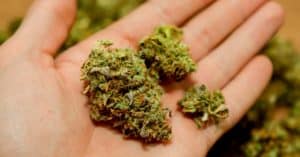It’s no secret that substance abuse and addiction are increasing in America, gradually decreasing our quality of life and negatively impacting families across the nation. While most people are aware of the ongoing opioid crisis in America, there are several additional addiction trends in the U.S. you should be aware of.
Table of contents
- 1. Synthetic drug abuse is on the rise.
- 2. Opioids continue to ravage America.
- 3. The U.S. life expectancy is dropping rapidly due to drug overdoses.
- 4. Americans’ views on marijuana are changing.
- 5. Stress and pain are driving Americans to abuse drugs.
- 6. Very few addicted Americans are getting addiction treatment.
- Getting Help: Detox is the First Step
1. Synthetic drug abuse is on the rise.
As synthetic drugs flood the nation, unsuspecting drug abusers continue to ingest harmful ingredients and chemicals that are unfit for human consumption. In recent years, the presence of synthetic drugs (also referred to as designer drugs) in America has increased, and the recent surge of fentanyl-related overdose deaths makes it clear that these drugs are a growing threat.
For example, a recent string of overdoses in New Haven, Connecticut was caused by K2, or synthetic marijuana, and the Department of Public Health had to deliver 50 doses of naloxone to the city of New Haven to replenish their supply after the outbreak.1
Similarly, hundreds of people in the midwestern states suffered medical emergencies after using synthetic cannabinoids laced with anticoagulant (found in rat poison) in July of 2018, meanwhile, the Delaware Department of Health issued a warning about heroin packets that had been linked to 106 deaths in 2018 thus far.2,3
Recent reports from the National Institute on Drug Abuse (NIDA) indicate that fentanyl (primarily illegal fentanyl) surpassed prescription opioids as the most common drugs involved in overdose deaths in the United States in 2016. Additionally, in 2016, synthetic opioids were involved in nearly 50% (19,413) of opioid-related deaths, up from 14% (3,007) in 2010.4
Now synthetic opioids like fentanyl are also showing up in other illicit drugs like cocaine, methamphetamine, and counterfeit pills, increasing users’ risks of overdose and death.5 Since synthetic opioid drugs like fentanyl and carfentanil are easy to produce and can be 100 times more potent than morphine, illegal drug manufacturers and dealers continue to smuggle smaller batches of it into the U.S. and then lace their drugs before flooding the market.
Number of drug submissions testing positive for fentanyl analogs and U-47700 in NFLIS in 2016 and during January–June 2017.
| Fentanyl Analog/Synthetic Opioid | 2016* | January-June 2017 |
| Carfentanil | 1,251 | 2,268 |
| Furanylfentanyl | 2,273 | 3,322 |
| 3-methylfentanyl | 427 | 432 |
| Acrylfentanyl | 26 | 1,508 |
| U-47700 | 533 | 1,087 |
*NFLIS Brief: Fentanyl and Fentanyl-Related Substances Reported in NFLIS, 2015–2016 & NFLIS 2016 Annual Report for U-47700.
^NFLIS 2017 Midyear Report.
Source: https://emergency.cdc.gov/han/HAN00413.asp
2. Opioids continue to ravage America.
Of course, we can’t talk about U.S. substance abuse trends without mentioning the opioid crisis. The American opioid epidemic began with an overprescribing of prescription opioids in the 1990s before it morphed into a surge of heroin overdose deaths in 2010 and then exploded with a drastic increase of overdose deaths caused by synthetic opioids.
Today, on average, 115 Americans die every day from an opioid overdose and more than 630,000 people have died from drug overdose since 1999.6

Drug overdoses in 2015 reached a new high of 52,404 deaths, and 33,000 of them involved opioids. That same year, drug overdoses killed more people than car crashes (38,022), gun deaths (36,252), or gun homicides (12,979).7 Unfortunately, things have only gotten worse since then.
On August 15, 2018, the Centers for Disease Control and Prevention (CDC) released preliminary estimates for 2017, with record-number overdose deaths reflecting a rise of about 10 percent: about 72,000 Americans died from drug overdoses in 2017.8 Experts believe the growing number of Americans using opioids is a primary factor in the drastic increase in overdoses.
While opioid abuse and addiction (and substance abuse in general) was historically a problem for low-income, uneducated individuals in urban areas, the opioid epidemic has become a widespread problem in recent years, sweeping up a broad population of users, both young and old, affluent and impoverished.
Prescription opioid abuse continues to be a major contributing factor in the ongoing opioid crisis, with increased accessibility to painkillers like OxyContin, Vicodin, Demerol, Methadone, and others. The amount of opioid drugs prescribed and sold in America has quadrupled since 1999, but the overall amount of pain reported by Americans hasn’t changed.9
A recent national poll found that 44% of Americans say they personally know someone who has been addicted to prescription painkillers and these drugs are killing more people than heroin.10
3. The U.S. life expectancy is dropping rapidly due to drug overdoses.

The life expectancy of Americans (which is an average of how long someone is expected to live) has been increasing in the U.S. over the past few decades. However, the opioid crisis has had a powerful impact on the overall health and well-being of Americans, reducing the life expectancy from 78.9 years in 2014 to 78.6 in 2016.11
Although this may not seem like a huge drop in life expectancy for one person, the chief of the mortality statistics branch at the National Center for Health Statistics told NPR otherwise. He says the drop is very concerning and that we haven’t seen the U.S. life expectancy drop for two consecutive years since 1962-63.
Even in lower-income countries, the life expectancy is increasing, reflecting scores of populations live longer and healthier lives. Many countries including Japan, Spain, and Australia all have life expectancies of 80 years or more, according to the World Health Organization, which makes the recent U.S. life expectancy decline even more shocking and concerning.12
4. Americans’ views on marijuana are changing.
Marijuana is still illegal under federal law and the DEA classifies it as a Schedule 1 Drug, meaning it has a high potential for abuse. Currently, it’s legal in 29 different states and its legality in other states is constantly changing.

Despite the harmful short-term and long-term side effects of marijuana abuse, marijuana is the most commonly used illicit drug in the U.S. and 22.2 million people reported using it in the last month.13 The increase in users is a stark difference from the 14.5 million users in 2007.
Back in 1969, only 12 percent of the American population thought marijuana should be legal. However, Gallup reported that in 2017, 64 percent of people favored legalizing marijuana. Overall, marijuana support is the highest its been in the last 50 years.14 Teens’ perceptions of the risks of marijuana have also declined over the past decade, which researchers speculate is a result of the loosening of policies surrounding its legality.
With the exception of alcohol, marijuana accounts for the greatest rates of dependence.15 Additionally, researchers still aren’t exactly sure what the risks of long-term marijuana abuse are. Despite its risks and adverse health effects, more and more Americans are beginning to look at marijuana use in a more favorable light, and that type of mindset may expand over time to include the use of other addictive substances.
5. Stress and pain are driving Americans to abuse drugs.
One of the most important current addiction trends to consider is the explanation for the increase in substance abuse and addiction in America. Not surprisingly, stress and pain are two of most powerful contributors to the U.S. addiction epidemic.

A study conducted by the American Psychological Association found that Americans are more stressed than they’ve ever been. Since 2014, average stress levels in the U.S. have risen from 4.9 to 5.1 on a 10-point stress scale. Additionally, 24 percent of adults report experiencing “extreme stress” in 2015 compared with just 18 percent in 2014. Money and work are consistently cited as the top two sources of stress.16
Chronic pain is also a major problem in the U.S., driving people toward the use and abuse of prescription opioid painkillers. According to the National Institutes of Health and the National Center for Complementary and Integrative Health, 25.3 million U.S. adults suffer from daily pain and 23.4 million report experiencing “a lot of pain.”17
Two of the most common reasons people start using drugs is to relieve pain and to cope with stress. When we consider the statistics mentioned above, the correlation between these two factors and the rise in American drug abuse
6. Very few addicted Americans are getting addiction treatment.
Drug and alcohol abuse in America is rampant, but few people get the help they need. Substance abuse among certain demographics is declining, but many addicted people still don’t have access to treatment. In fact, 8.6 percent of Americans need professional treatment for substance abuse problems and/or addiction, but only 0.9 percent obtain specialized treatment.15 Additionally, of those 44 percent of people who know someone who is addicted to painkillers, 61 percent said they were concerned about a lack of treatment.10

People suffering from addiction and substance abuse may not enroll in treatment due to several different factors, including:
- A lack of education about addiction and addiction treatment
- A lack of resources (such as in an extremely rural area)
- Financial problems that prevent people from paying for professional treatment
- Fear of what other people will say or think
- Denial that the substance abuse is a serious problem
- Misconceptions about the efficacy of professional addiction treatment
Getting Help: Detox is the First Step
If you, like so many others, are struggling with addiction and substance abuse, drug detox is the first step to achieving a stable life in recovery. It’s never too late to get help, despite your circumstances. Briarwood Detox Center provides evidence-based addiction detox treatment and medication-assisted treatment to ensure you have the most comfortable and safe detox experience possible. Call Briarwood to speak with an admissions representative today.
References:
- https://portal.ct.gov/Office-of-the-Governor/Press-Room/Press-Releases/2018/08-2018/Gov-Malloy-Statement-on-Outbreak-of-Overdose-Cases-in-New-Haven
- https://www.fda.gov/NewsEvents/Newsroom/PressAnnouncements/ucm614027.htm
- https://news.delaware.gov/2018/05/29/delaware-health-officials-issue-warning-2-deaths-involve-stamp-packets-heroin/
- https://www.drugabuse.gov/related-topics/trends-statistics/infographics/fentanyl-other-synthetic-opioids-drug-overdose-deaths
- https://www.healthline.com/health-news/deadly-synthetic-opioids-in-cocaine-and-other-drugs#4
- https://www.cdc.gov/drugoverdose/epidemic/index.html
- https://www.vox.com/science-and-health/2017/3/23/14987892/opioid-heroin-epidemic-charts
- https://www.cdc.gov/nchs/nvss/vsrr/drug-overdose-data.htm
- https://www.cdc.gov/drugoverdose/pdf/guidelines_at-a-glance-a.pdf
- https://www.ncadd.org/blogs/in-the-news/44-of-americans-know-someone-who-has-been-addicted-to-prescription-painkillers
- https://www.npr.org/sections/health-shots/2017/12/21/572080314/life-expectancy-drops-again-as-opioid-deaths-surge-in-u-s
- https://www.usatoday.com/story/news/2017/12/21/u-s-life-expectancy-drops-second-year-drug-deaths-spike-cdc/970283001/
- https://www.drugabuse.gov/publications/research-reports/marijuana/what-scope-marijuana-use-in-united-states
- http://news.gallup.com/poll/221018/record-high-support-legalizing-marijuana.aspx
- http://time.com/4253107/americans-are-getting-more-stressed-out-study-finds/
- https://nccih.nih.gov/news/press/08112015


